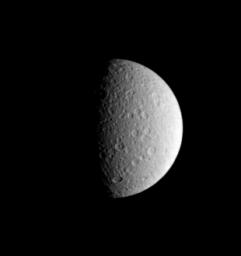
|
Rhea’s Memory
- Click the image above for a larger view
- Full-Res JPEG (310 x 329) (4.9 kB)
- Full-Res TIFF (310 x 329) (102.3 kB)
Caption:
The story of the solar system is written upon the faces of its many worlds, such as Saturn's icy moon Rhea, seen here in an image from Cassini. The moon's many impact craters attest to its violent beginnings and more than four billion years of subsequent history. Rhea is 1,528 kilometers (949 miles) across.
Most moons in the outer solar system are icy, in contrast to the rocky inner planets and Earth's moon. When the planets and their moons first formed around our Sun, conditions were cold enough at Saturn's distance that ices could condense to form solid bodies like Rhea. Since its formation, Rhea has been battered by the leftover debris of planet building, although at a much lower rate for the past 3.8 billion years or so.
North on Rhea is up and rotated about 20 degrees to the left. This view shows principally the leading hemisphere on Rhea.
The image was taken in visible light with the Cassini spacecraft narrow-angle camera on May 5, 2005, at a distance of approximately 1.4 million kilometers (900,000 miles) from Rhea and at a Sun-Rhea-spacecraft, or phase, angle of 78 degrees. The image scale is 9 kilometers (6 miles) per pixel.
Background Info:
The Cassini-Huygens mission is a cooperative project of NASA, the European Space Agency and the Italian Space Agency. The Jet Propulsion Laboratory, a division of the California Institute of Technology in Pasadena, manages the mission for NASA's Science Mission Directorate, Washington, D.C. The Cassini orbiter and its two onboard cameras were designed, developed and assembled at JPL. The imaging team is based at the Space Science Institute, Boulder, Colo.
For more information about the Cassini-Huygens mission visit http://saturn.jpl.nasa.gov . For additional images visit the Cassini imaging team homepage http://ciclops.org .
Cataloging Keywords:
| Name | Value | Additional Values |
|---|---|---|
| Target | Rhea | |
| System | Saturn | |
| Target Type | Satellite | |
| Mission | Cassini-Huygens | |
| Instrument Host | Cassini Orbiter | |
| Host Type | Orbiter | |
| Instrument | Imaging Science Subsystem (ISS) | |
| Detector | Narrow Angle Camera | |
| Extra Keywords | Crater, Grayscale, Impact, Rotation, Visual | |
| Acquisition Date | ||
| Release Date | 2005-06-23 | |
| Date in Caption | 2005-05-05 | |
| Image Credit | NASA/JPL/Space Science Institute | |
| Source | photojournal.jpl.nasa.gov/catalog/PIA07527 | |
| Identifier | PIA07527 | |
